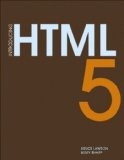
If you’re like me, you’re seeing all the hype about video in HTML 5 and thinking “that’s nice, but what else?”
As a web developer going on 10 years of working on the web, I was looking for a quick way to get caught up on the “what else” without having to read through 3 chapters of how HTTP is a stateless protocol and who Tim Berners-Lee is and get straight into some practical examples. Well, that’s exactly what the new title, Introducing HTML5, does. And all in under 250 pages.
Book: Introducing HTML5
The New Semantic Web
After a nice intro on how the HTML5 spec actually came about, the authors devote the first third of the book diving into the new, more meaningful tags touted by the HTML5 spec that should ultimately replace all the DIV tags that we’ve been using ever since table tags were ousted for layouts 5 years ago. The book’s examples of the header, footer, and article tags, as well as the new form validation attributes demonstrated in the context of a typical blog will certainly appeal to many of us out there with an “ah ha” moment.
The other refreshing element that the authors touch on thorough the book is accessibility. While often overlooked on the web in most development books, these guys definitely take away your “I didn’t think of that” excuse. After reading this book, you’ll definitely know what you’re not today to help those non-sighted or otherwise impaired users of your website or app.
A Little Bit of Video
Halfway through the book, there’s a short chapter on the audio and video tags; more so on how they are to be used and not the parading “kill flash” banter you read everywhere else on the web. If you only want HTML5 for the video tags, this book isn’t for you.
Along with video, there’s an in-depth look at the canvas tag and the related API. While an interesting topic to cover, I can’t think of any immediate uses in my own development plans. Still, it lets you see what else is included in the spec.
Build Me a Web App
Spending almost all of my professional career working with Microsoft technologies, most of my application building has been using WinForms, ViewState, and Session management to handle some of the issue stateless session and cookie headaches, I can certainly appreciate the new features in the HTML5 spec to make things a little easier on my open source work.
In fact, the too biggest reasons I wanted to dive into HTML5 were the local storage and offline access features. While short and to the point, these chapters are a good enough example to know what to use and when, all within the context of HTML and JavaScript. Now, there will no doubt be libraries built on top of the main spec elements to help us with our PHP or similar applications, but getting to know the basics in such a simple format is always a big help.
Wrap Up
In short, this book is a great read if you just want a primer to know the what and why of the new HTML5 spec before venturing into more in-depth titles on the specifics of a particular topic. The fact that it’s short, to the point, and has pretty relevant examples in it are all big selling points for me. The humor and the dual authors’ subtle digs at each other is rather entertaining, too. 🙂
Book cover image credit: Amazon.com






